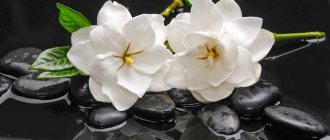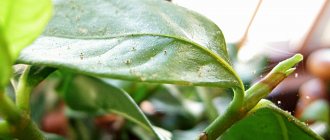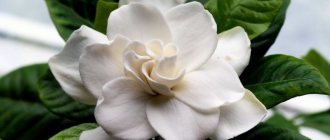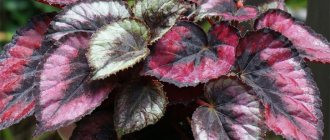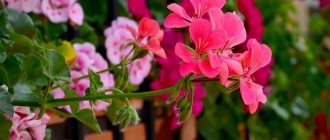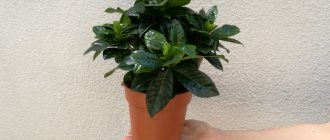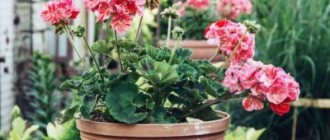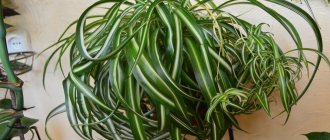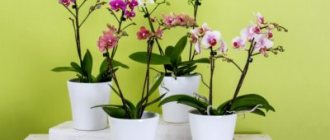Gardenia is an exotic beauty that began its historical journey from Japan and China. People first started talking about it back in the 19th century. In those romantic hours, gardenia adorned the clothes of noble nobles. Later, she was unfairly forgotten. And only recently has gardenia taken pride of place in the gardens and premises of lovers of beauty.
This beautiful flower received its name from the American scientist and naturalist A. Garden. He cultivated gardenia and introduced it to people. Read about hibiscus photos and home care here.
What attracts you to this proud beauty? At first glance, gardenia looks like a beautiful artificial wax flower with lush green leaves. But what is most striking is its intoxicating aroma.
[AdSense-A]
Even one flower blooming on a bush will fill the room with an unforgettable aroma.
More than 250 species of gardenia are known. Under natural conditions, the flower can reach a height of three meters, and compact species are grown indoors. The flowering period falls on June-September. Simple flowers or flowers collected in inflorescences appear on the bush.
The variety of colors delights everyone who sees this miracle of nature. Flowers can be simple or double, and reach a diameter of 8-10 cm.
The gardenia bush, having long (up to 10 cm) leathery leaves, acquires a decorative appearance even without a blooming flower.
Gardeners consider gardenia to be a very capricious and demanding plant. Therefore, before purchasing this flower, you need to study the rules of caring for it.
Botanical description
Gardenia belongs to the Rubiaceae family and is an evergreen shrub, but some varieties come in the form of trees. Gardenia is native to the subtropical regions of Japan and China , but is also native to the African continent and Asia. It first appeared in the notes of the American botanist Alexander Garden, who cultivated this flower in his own greenhouse in the 18th century.
The evergreen shrub has a woody, branched stem and strong, bare or pubescent shoots. Some species have spines on them.
Gardenia in the form of a tree grows to a height of 2-3 m. The leaves of the plant are smooth, leathery, oval in shape, dark green in color.
Large flowers, up to 10 cm in diameter , are located at the end of the shoots or in the axils of the leaves. Single, semi-double or double flowers have a wide variety of colors, including yellow, white, pink, cream and orange shades.
Dry or fleshy fruits are presented in the form of a cylindrical or pear-shaped box with a large number of seeds. The fruits crack in different ways, depending on the type of gardenia.
When does it bloom?
In order for a plant to bloom in a room, it needs to create suitable conditions. Gardenia blooms in the summer - from May to August. The flowers are mostly solitary, but sometimes collected in inflorescences of 3-5 pieces.
The scent of gardenia is so strong that even one flower is enough to fill an entire room with a heavy, intoxicating aroma . For this reason, it is not recommended to place a container with this shrub in the bedroom or children's room.
Transplanting gardenia
Young seedlings need to be transplanted as the pot fills with roots. Transplantation should always be carried out using the transshipment method. To do this, the lump of soil is carefully pulled out of the pot and transplanted into another pot. Its size should be 2 cm larger than the previous one.
Gardenias from the store need to be replanted, since the soil is intended only for transportation and does not contain nutrients. Only before this procedure, the plant must undergo adaptation to new conditions. Adult specimens are transplanted if necessary: illness, small pot.
The contents of the flowerpot are pulled out and the roots are examined. If there are rotten ones, they must be cut down to living tissue, and the cut should be treated with activated carbon. The bottom of the pot is occupied by drainage, then a small layer of soil and a flower with a lump of earth sits. Fresh soil is poured along the edges.
Trimming. Young plants are pinched at the tops of the shoots. After flowering, it is necessary to shorten the shoots that thicken the bush, weak specimens. Trim dried branches as soon as they appear.
Varieties and photos
The wide variety of gardenia species is divided into 2 groups:
- garden or street;
- indoor
It is not always possible to grow a plant in the garden, since it does not tolerate temperatures below minus 10°C. Only Thunberg gardenia can often be found in natural conditions, since it is less demanding on temperatures.
Among the domestic species, the most popular is gardenia jasmine or rooting, which is also called Cape jasmine, Gardenia Augusta and regal.
Below are photos, names and descriptions of Gardenia varieties suitable for propagation and care at home:
Jasmine
This is a compact evergreen bush, which at home grows to a height of 0.5-0.8 m, and in nature reaches 2 m . The leaves are thick, dark green, shiny, with a pointed edge, up to 8 cm long. Blooms in late spring and early summer, with large fragrant flowers, similar to roses, ranging in color from bright white to creamy yellow.
There are several varieties of jasmine gardenia, which differ not only in appearance, but also in the duration of flowering (until early January). The photo below shows Gardenia Jasmine:
Tahitian
The habitat of this plant species is Tahiti, where gardenia grows to a height of up to 7 m. The flowers are double, single, white. You can see what the Gardenia Tahitian variety looks like in the photo below:
Thunberg
This variety is not picky about soil, so it is quite easy to grow, giving it the shape of a tree. Creamy white single flowers up to 8 cm in diameter have a very strong aroma, especially at night.
Nitida
This is an unpretentious and profusely flowering variety that can be grown not only indoors, but also in garden beds protected from the wind. The flowers resemble starfish in appearance. The leaves are quite large, elongated, with dark veins and tubercles. The flowers appear on long, soft shoots that are pale green at the base and become lighter as they grow longer.
Kula
This variety of gardenia, in comparison with other species, has flowers that can change color. At first they have a white tint, which then changes to lemon, and then to orange. Gardenia Kula grows quite slowly, in natural conditions it reaches 15 m. In the photo below, the Gardenia Kula variety is shown:
How to water gardenia - about care at home
If we talk about caring for gardenia jasmine at home, then we pay special attention to watering - in winter we use only warm water. In summer, watering does not cause any special problems. We do everything as usual - we water our beauty well, make sure that after watering there is no moisture left in the trays. How to water gardenia correctly so as not to cause bacterial and fungal diseases? Let's try to figure it out.
In spring and summer, during the period of active growth, the surface layer of the earth can dry out to a dry state - you can determine this in the simplest way - by touch, with your finger, if you don’t feel moisture - water! In autumn and winter, when the temperature is lower and the daylight hours are shorter, the gardenia can dry out up to 1.5 cm deep into the pot. If it has dried out 1-1.5 cm deep into the pot, water it! We make sure to remove the excess so as not to cause root rot!
Care
This is a plant that is demanding in terms of growing conditions, which most often does not live long in apartment conditions. In unfavorable conditions, it can die in the first year, but with proper care it grows for about 10 years . In the wild, gardenia grows fully until 15-20 years.
To admire the beautiful flowers of gardenia, you need to create and constantly maintain favorable conditions for it:
Lighting
The long and abundant flowering of gardenia is directly related to the sufficient lighting that the plant requires almost 24 times a day, which is not very easy to achieve. This flower prefers diffused light, because sun rays cause burns on the top of the leaves. A long stay in the open sun leads to the death of the plant.
It is best to place a gardenia pot on a window on the east or west side, since there is little light on the north side, but there is enough light on the south side, but there the
bright sun can leave burns on the leaves .
Also, drafts should not be allowed in the room where the flower is located.
In cold weather, this plant requires additional lighting for at least 12 hours a day.
It is strictly forbidden to turn the pot even half a turn or move the flower in winter. Gardenia may die from this.
Temperature
In summer and winter, the plant requires different temperature regimes. In the warm season, the comfortable temperature will be +22-25°C, and in the winter – +16-18°C . In winter, flower buds are formed in gardenia, and at high temperatures these processes slow down or stop altogether. Therefore, it cannot be placed next to heaters, radiators and air conditioners.
In summer, at temperatures of +30°C and above, flower growth stops, so the pot must be urgently moved to the shade. In the warm season, the plant can be moved to a loggia or balcony, while preventing direct sun from hitting the foliage.
At home, the soil and air temperatures should be approximately the same, since the roots should not be overcooled.
Sudden temperature changes have a negative impact on future flowering.
Humidity and watering
Depending on the time of year, watering rules change, so gardenia is a capricious shrub that is difficult to grow. In summer, when active growth is observed, the flower should be watered abundantly , but only after the top of the soil has completely dried. In autumn and spring, the plant is watered 2-3 days after the top layer of soil has dried, and in winter the frequency and abundance of watering is further reduced. At any time of the year, it is undesirable to over-moisten the soil, as the roots may rot.
For irrigation, you need to use slightly warm water, and also water that has been standing for at least a day (or it needs to be pre-purified). Rainwater can also be used.
Since gardenia requires slightly acidified soil for normal and healthy growth, it is sometimes allowed to add a little lemon juice to the water.
Only here the main thing is to observe the measure - otherwise the leaves will turn yellow and slowly begin to crumble. The optimal dosage is 5-7 drops of freshly squeezed lemon juice per 1 liter of water.
The plant also needs high air humidity - when the buds are closed, the flower needs to be sprayed every day, and in hot and dry periods - 2 times a day.
As soon as the buds open, spraying stops so as not to spoil the decorative effect of the flowers, on the petals of which yellow spots will appear from the water. To maintain air humidity during the flowering period, you can place a container of water next to the pot.
Top dressing
In the warm season, gardenia needs regular fertilization. As a top dressing, it is permissible to use special complex formulations for indoor and flowering plants.
It is important to pay attention to the calcium contained in the fertilizer , the excess of which will harm the flower. If the microelement level is high, it is recommended to reduce the degree of saturation of the composition when fertilizing the soil. In winter, gardenia does not need additional feeding; it needs to rest.
During bud setting and flowering, soil acidity can be reduced using preparations with a high iron content. They should be applied 2 times in a certain period.
It is possible to understand that a flower is ready for fertilizing based on the condition of its roots. If they have spread along the bottom of the pot, and the moisture entering the soil is quickly absorbed, then the gardenia can be fed with different fertilizers, alternating them with each other.
Transfer
Gardenia is a capricious plant that cannot tolerate transplantation at all. Therefore, it should be carried out only when absolutely necessary.
How to choose the right pot?
The volume of the container should be slightly larger than the size of the root system. at the bottom for water drainage . A flower pot can be either plastic or ceramic, but in the first case it is more convenient to water from a tray.
Priming
Since gardenia has fragile roots that are easily damaged, it is better to replant using the method of transshipment together with a lump of earth. Transplantation is performed in early spring or autumn.
A suitable container should be filled 1/3 with drainage, and the rest with suitable soil. At the same time, the soil should be loose so that the thin roots of gardenia can easily grow in it.
The best option would be a ready-made soil mixture recommended for azaleas with an acidity level of 4.0-5.5 .
You can make the soil for the flower yourself: take leaf, peat and coniferous soil in equal quantities, as well as a little sand. You can put sphagnum on top of the soil. This moss absorbs moisture well.
Trimming
You can maintain the decorative appearance of gardenia by regularly pruning the side branches. During this procedure, wilted flowers and buds, as well as diseased and dry shoots, are removed. As the greenery grows strongly, it is permissible to thin out the dense foliage and also pinch the tops. Healthy pruned shoots are used for cuttings.
Light
As we have already mentioned, the lighting must be constant. The south side of the house is not suitable due to the presence of sunlight, so if possible, give the plant a western or eastern window.
In winter, try not to move or turn the flower, otherwise it may crumble and stop growing. Also, avoid drafts.
Reproduction
There are two ways to get a new plant:
From seeds
This is an easier method of propagation, but to successfully obtain new seedlings you need to take only fresh seeds. The day before sowing the seeds, they are soaked in a growth stimulant , for example, aloe juice.
After this, they are placed in a container with soil, under which there is necessarily expanded clay drainage. Sprinkle the seeds on top with a 0.5 cm layer of soil. Then the ground is generously sprayed and covered with film, making a greenhouse, which is ventilated every day. The seeds germinate in about a month. When the seedlings grow up, they are transplanted into separate pots.
Cuttings
With the vegetative method of propagation, cuttings 8-10 cm long are cut from the mother plant with a sharp knife. In this case, the cut should be neat and even. Before planting in the ground, all lower leaves are removed from the cuttings, and then the shoots are kept for at least 30 minutes in a weak solution of potassium permanganate. This action helps destroy parasites and prevent the occurrence of fungal diseases. It is also recommended to sprinkle the tips of the cuttings with a preparation that stimulates root growth.
Then the prepared cuttings are planted in a container with a soil mixture of peat and river sand. There must be drainage at the bottom of the pot. The soil temperature should not be lower than 24°C .
The planted cuttings need to create a greenhouse, for which they need to be covered with a bag or jar. Once a day, the greenhouse is opened for 2 hours for ventilation, and the cuttings are sprayed with soft warm water.
Rooting takes about a month and is considered successful when young leaves appear on the cuttings. After this, the young plants can be planted in separate pots filled with peat, pine humus and sand.
Why doesn't Gardenia bloom?
There may be several reasons:
1. One of the common reasons why Gardenia does not bloom is dry air.
2. If the room temperature is more than 24 degrees and less than 12, then Gardenia will not bloom.
3. Also, the reason for this may not be acidic soil. To maintain acidity, when watering, you need to add lemon juice to the water; instead of lemon juice, you can use natural apple cider vinegar. This should be done once a month.
4. The reason may be untimely pruning of Gardenia after flowering; this must be done before new buds appear.
5. If the buds develop and then suddenly fall off, it may be a sign of lack of sunlight or the soil's acidity is not suitable.
6. Another reason: lack of nutrients in the substrate.
7. Gardenia may not bloom due to a pest attack, it could be: spider mites, aphids or mealybugs. You can also acidify the soil using coffee grounds. Spread the coffee grounds over the substrate before watering the plant.
Diseases and pests
To grow gardenia and enjoy its beautiful flowers, you need to create favorable conditions for it. But if there are mistakes in caring for the plant, you can see the following problems:
Drops buds
Buds fall off with the following errors:
- lack of light;
- cold room temperature – below 16°C;
- improper watering, drying out of the soil;
- use of cold water for irrigation;
- moving the pot during flowering or bud formation.
Buds don't bloom
This happens in the following cases:
- acidification of the soil is necessary;
- insufficient lighting.
The leaves are turning yellow
Typical mistakes that lead to yellow foliage:
- the gardenia pot is in a draft;
- temperature standards in the room are not met;
- the use of cold water when watering or it is not settled.
Leaves are drying
Occurs when the following care errors occur:
- drying out of the substrate caused by improper watering;
- high room temperature or dry air;
- damage by pests and diseases.
Leaves turn black
This issue occurs in the following cases:
- excessive watering;
- pests;
- drafts;
- low soil air temperature.
The main pests that attack gardenia are:
- thrips - on the upper part of the leaves you can see many gray dots;
- spider mite - leaves are covered with cobwebs and curl;
- aphids – flowers and leaves become slightly sticky to the touch;
- scale insect - leaves dark brown round spots on the leaves - scutes.
To see pests, you need to carefully examine the plant, and then, when they are detected, you need to immediately begin fighting them in order to save the flower. To combat insects, you need to take special insecticidal preparations, which are used according to the instructions indicated on the package.
How to stimulate Gardenia to bloom?
In order for Gardenia to produce flower buds , it needs cool nights with a temperature of about 15 degrees and warm days with a temperature of 23 degrees.
At higher temperatures, flower buds simply do not form.
Flowering also requires a lot of indirect light, several hours a day.
To prevent the buds from falling off during flowering , you need to maintain soil moisture, but be careful not to flood it with water.
Photo gallery
flowerschannel
pro_flowers74
kaktus100faktus
galinaplatosha
pro_flowers74
plant.my.home
